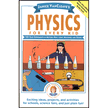What is Gravity? How is Gravity Measured?
Gravity is the force of attraction between two bodies due to their mass and distance from each other.

The double headed arrow indicates that the force of gravity pulls the person toward the Earth, and vise versa. In this tug-of-war, who do you think will be the winner?
The magnitude of the gravitational force between two objects can be determined using the following equation:
Newton’s Equation for the Force of Gravity
F = G x m1 x m2/d2
F represents the force of gravity between the objects. For Newton’s equation, the metric force unit is Newton, N.
G is the gravitational constant, which is 6.67 x 10-11 N·kg2/ m2 .
This is a very small number, thus gravity is a very weak force in comparison to other forces. This is why you do not notice any force of attraction between you and another person or even a building. You do notice the force of gravity between you and the Earth because the mass of the Earth is so very large. In fact, when you fall, you accelerate toward the Earth at a rate of
9.8 m/ sec2 .
In Newton’s equation, m1 and m2 represent the individual masses of the two objects measured in the metric mass unit of kilogram, kg. When the two masses are multiplied together the unit for the product is kg2 , read as kilogram squared.
The symbol “d” in the equation represents the distance between the centers of the two objects. For this example, the objects are the earth and the person in the diagram. The metric unit for distance used is meter, m. The equation shows the distance to be squared, d2 , thus the unit of measurement (m) would be meter squared, m2 .
For Example:
Calculate the force of attraction between the person in the diagram who has a mass of 63.5 Kg and the Earth, with a mass of 5.95 x 1024 kg.
The radius of Earth is 6.378 x 106 m is so large, that the distance from Earth’s surface to the center of the person’s body is considered negligible–meaning it is not considered. So the distance for Newton’s equation is the radius of the Earth.
Fact:
G = 6.67 x 10-11 N·kg2/ m2
F = G x m1 x m2/d2
F = (6.67 x 10-11 N·kg2/ m2 ) (5.95 x 1024 kg)(63.5 kg) ÷ (6.378 x 106 m)2
F = 6.20 x 102 kg·m/sec2
= 6.20 x 102 N
The force of gravity between two objects is the amount of attractive force that each object has for the other.In the above example, the person’s body tugs on the Earth with a force of 6.20 x 102 N. At the same time, the Earth tugs on the person with the same amount of force, 6.20 x 102 N. Yes, gravity is much like the game of tug-of-war. While the tugging force on each object is the same, whether there is any movement depends on the differences between their mass.
Challenge:
The weight of an object is a measure of Earth’s force of gravity pulling the object toward the center of Earth. Thus, when you stand on a bathroom scale, the face of the scale indicates how much force is pushing down on the scales. This downward push (force) is the Earth’s force of gravity pulling your body down. The weight measurement on the scale is the measure of the Earth’s force of gravity on your body.
In the example above, the force of gravity acting on the person is
6.20 x 102 N. What is the process for calculating the weight of the person in pounds using 1N:2.2 x 10-2lb. Clue: The answer is 124 pounds. The problem is determining how to find this answer.
 |
Physics Experiments and Investigations For Every Kids |